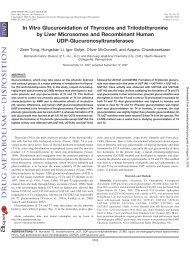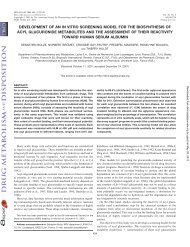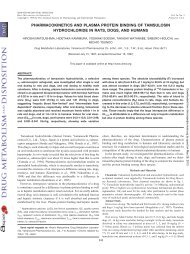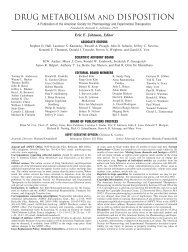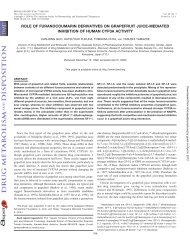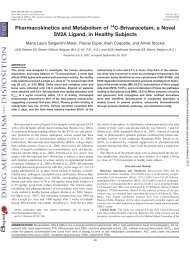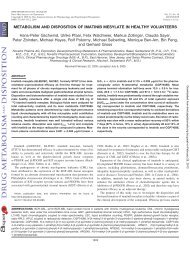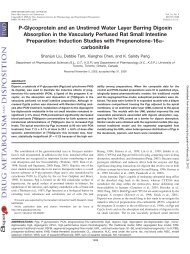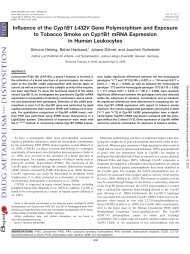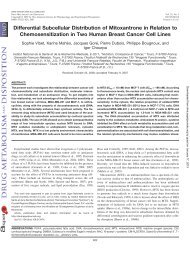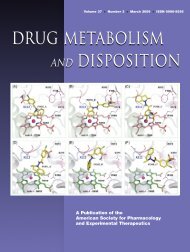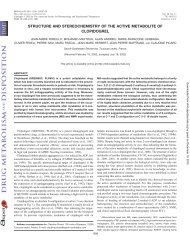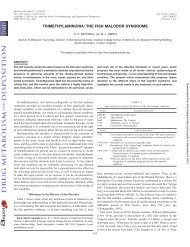glucuronidation of r- and s-ketoprofen, acetaminophen, and ...
glucuronidation of r- and s-ketoprofen, acetaminophen, and ...
glucuronidation of r- and s-ketoprofen, acetaminophen, and ...
You also want an ePaper? Increase the reach of your titles
YUMPU automatically turns print PDFs into web optimized ePapers that Google loves.
0090-9556/99/2701-0026–31$02.00/0<br />
DRUG METABOLISM AND DISPOSITION Vol. 27, No. 1<br />
Copyright © 1999 by The American Society for Pharmacology <strong>and</strong> Experimental Therapeutics<br />
Printed in U.S.A.<br />
GLUCURONIDATION OF R- AND S-KETOPROFEN, ACETAMINOPHEN, AND DIFLUNISAL<br />
BY LIVER MICROSOMES OF ADJUVANT-INDUCED ARTHRITIC RATS<br />
CHRISTINE J. MEUNIER AND ROGER K. VERBEECK<br />
Pharmacokinetics <strong>and</strong> Drug Metabolism Laboratory, School <strong>of</strong> Pharmacy, Catholic University <strong>of</strong> Louvain, Brussels, Belgium<br />
(Received April 15, 1998; accepted July 15, 1998)<br />
This paper is available online at http://www.dmd.org<br />
ABSTRACT:<br />
The effect <strong>of</strong> adjuvant-induced arthritis on hepatic microsomal<br />
<strong>glucuronidation</strong> was studied in the rat. Arthritis was induced by<br />
injection <strong>of</strong> Mycobacterium butyricum suspended in liquid paraffin.<br />
V max <strong>and</strong> the Michaelis-Menten constant values for the in vitro<br />
<strong>glucuronidation</strong> <strong>of</strong> R- <strong>and</strong> S-ketopr<strong>of</strong>en, <strong>acetaminophen</strong>, <strong>and</strong> diflunisal<br />
by liver microsomes obtained from control <strong>and</strong> adjuvant-induced<br />
arthritic rats were compared. In addition, uridine 5-diphosphateglucuronosyltransferase<br />
activity toward bilirubin <strong>and</strong> p-nitrophenol,<br />
as well as levels <strong>of</strong> cytochrome P-450 <strong>and</strong> -glucuronidase were<br />
determined in these microsomal preparations. Adjuvant-induced<br />
arthritis resulted in a significant reduction in hepatic cytochrome<br />
P-450 levels <strong>and</strong> in p-nitrophenol <strong>glucuronidation</strong> (5.65 0.40<br />
versus 2.58 0.27 molmin/mg protein in control <strong>and</strong> arthritic<br />
rats, respectively, mean S.E.M.). Glucuronidation <strong>of</strong> bilirubin <strong>and</strong><br />
-glucuronidase activities in liver microsomes <strong>and</strong> in plasma were<br />
The pharmacokinetics <strong>of</strong> a number <strong>of</strong> drugs is altered in patients<br />
with chronic inflammatory diseases, such as rheumatoid arthritis<br />
(Harris, 1981). The most likely causes involved are altered distribution<br />
<strong>and</strong>/or abnormal metabolism. Adjuvant-induced arthritis in rats,<br />
which resembles the human disease both clinically <strong>and</strong> histologically,<br />
is a widely used animal model to evaluate drug c<strong>and</strong>idates for the<br />
treatment <strong>of</strong> rheumatoid arthritis. This animal model has also been<br />
used to investigate the effect <strong>of</strong> experimentally induced arthritis on<br />
drug metabolism. For example, in adjuvant-induced arthritic rats<br />
pentobarbital sleeping time was shown to be increased <strong>and</strong> hepatic<br />
activation <strong>of</strong> cyclophosphamide was reduced (Beck <strong>and</strong> Whitehouse,<br />
1973; Dipasquale et al., 1974). This abnormal drug metabolism in<br />
adjuvant-induced arthritic rats was related to reduced cytochrome<br />
P-450 (CYP-450) 1 content in the liver (Cawthorne et al., 1976; Toda<br />
et al., 1994). Buchar <strong>and</strong> Janku (1985) have suggested that adjuvantinduced<br />
arthritis alters the phospholipid composition <strong>of</strong> the endoplasmic<br />
reticulum in the liver as a result <strong>of</strong> decreased synthesis <strong>of</strong><br />
phosphatidylcholine <strong>and</strong> phosphatidylethanolamine. Consequently,<br />
1 Abbreviations used are: CYP-450, cytochrome P450; UDP, uridine 5diphosphate;<br />
UGT, UDP-glucuronosyltransferase; UDPGA, UDP-glucuronic acid;<br />
HPLC, high-performance liquid chromatography; AG, <strong>acetaminophen</strong> glucuronide;<br />
R-KG, R-ketopr<strong>of</strong>en glucuronide; S-KG, S-ketopr<strong>of</strong>en glucuronide; DPG,<br />
diflunisal phenolic glucuronide; DAG, diflunisal acyl glucuronide; UGT-pnp, UGT<br />
activity toward p-nitrophenol.<br />
Send reprint requests to: Dr. Roger K. Verbeeck, UCL/FATC 7355, School <strong>of</strong><br />
Pharmacy, Av. E. Mounier 73, 1200 Brussels, Belgium email: verbeeck@fatc.ucl.ac.be<br />
26<br />
not affected by adjuvant-induced arthritis. V max (nmol/min/mg protein)<br />
for the formation <strong>of</strong> R-ketopr<strong>of</strong>en glucuronide, S-ketopr<strong>of</strong>en<br />
glucuronide, diflunisal phenolic glucuronide, <strong>and</strong> diflunisal acyl<br />
glucuronide was significantly decreased in arthritic rats (0.68 <br />
0.10, 0.77 0.12, 0.044 0.005, 0.26 0.03, respectively) compared<br />
with control rats (1.45 0.04, 1.60 0.04, 0.087 0.008,<br />
0.46 0.04, respectively). Glucuronidation <strong>of</strong> p-nitrophenol, ketopr<strong>of</strong>en<br />
<strong>and</strong> diflunisal, substrates which seem to be at least partly<br />
glucuronidated in the rat by isoenzymes <strong>of</strong> the UGT2B subfamily,<br />
was impaired in adjuvant-induced arthritis. Glucuronidation <strong>of</strong> bilirubin<br />
<strong>and</strong> <strong>acetaminophen</strong>, substrates <strong>of</strong> UGT1- isoenzymes, was<br />
not affected by adjuvant-induced arthritis. It seems, therefore, that<br />
adjuvant-induced arthritis in the rat leads to impaired <strong>glucuronidation</strong><br />
<strong>of</strong> substrates <strong>of</strong> the UGT2B subfamily.<br />
this alteration may lead to impairment <strong>of</strong> microsomal enzymes. Other<br />
reports have shown that interleukin-1, a cytokine mediator <strong>of</strong> inflammation,<br />
decreases the activity <strong>of</strong> hepatic CYP-450 in the rat (Sugita et<br />
al., 1990; Poüs et al., 1990).<br />
Although the effect <strong>of</strong> adjuvant-induced arthritis on drug metabolism<br />
has been relatively well documented as far as CYP-450 catalyzed<br />
reactions are concerned, little information is available in the literature<br />
on the <strong>glucuronidation</strong> <strong>of</strong> drugs in experimentally induced arthritis in<br />
the rat (Toda et al., 1994). Glucuronidation <strong>of</strong> endo- <strong>and</strong> xenobiotics<br />
is catalyzed by the uridine 5-diphosphate (UDP)-glucuronosyltransferase<br />
(UGT) system (EC 2.4.1.17), a family <strong>of</strong> closely related isoenzymes<br />
mainly located in the endoplasmic reticulum <strong>and</strong> exhibiting<br />
different, but overlapping, substrate specificities (Clarke <strong>and</strong> Burchell,<br />
1994). The products <strong>of</strong> this conjugation reaction, i.e., -glucuronides,<br />
are substrates for the hydrolytic enzyme -glucuronidase. It has<br />
recently become evident that the -glucuronidase catalyzed hydrolysis<br />
<strong>of</strong> certain glucuronide conjugates is so fast that it can affect the<br />
overall <strong>glucuronidation</strong> <strong>of</strong> a compound. Such futile <strong>glucuronidation</strong>de<strong>glucuronidation</strong><br />
cycling has been shown to occur in vitro (microsomes,<br />
intact cells) as well as in vivo (Brunelle <strong>and</strong> Verbeeck, 1993;<br />
Kauffman, 1994; Brunelle <strong>and</strong> Verbeeck, 1997). Some reports in the<br />
literature indicate that serum <strong>and</strong>/or -glucuronidase activities are<br />
increased in patients with rheumatoid arthritis (Falkenbach et al.,<br />
1993) <strong>and</strong> in rats with adjuvant-induced arthritis (Reddy <strong>and</strong> Dhar,<br />
1991). Whether this increase in -glucuronidase activity in arthritic<br />
conditions is related to altered hepatic -glucuronidase activity is not<br />
known.<br />
We therefore decided to investigate the effect <strong>of</strong> adjuvant-induced<br />
Downloaded from dmd.aspetjournals.org by guest on August 22, 2013
ADJUVANT-INDUCED ARTHRITIS AND GLUCURONIDATION<br />
27<br />
arthritis on the hepatic microsomal <strong>glucuronidation</strong> <strong>of</strong> three different<br />
substrates. Ketopr<strong>of</strong>en <strong>and</strong> <strong>acetaminophen</strong> were selected because they<br />
are glucuronidated by different UGT isoenzymes in the rat (Clarke<br />
<strong>and</strong> Burchell, 1994). In addition, the in vitro <strong>glucuronidation</strong> <strong>of</strong><br />
diflunisal was investigated by using liver microsomes <strong>of</strong> control <strong>and</strong><br />
adjuvant-induced arthritic rats. Diflunisal is an interesting substrate<br />
for studying glucuronide conjugation because it forms two different<br />
types <strong>of</strong> glucuronides (i.e., both a phenolic <strong>and</strong> an acyl glucuronide)<br />
<strong>and</strong> because the in vitro formation <strong>of</strong> its acyl glucuronide is significantly<br />
influenced by the microsomal -glucuronidase activity<br />
(Brunelle <strong>and</strong> Verbeeck, 1993).<br />
Materials <strong>and</strong> Methods<br />
Chemicals <strong>and</strong> Reagents. Pure R- <strong>and</strong> S-ketopr<strong>of</strong>en enantiomers were<br />
kindly supplied by Dr. M. R. Martinet (Rhône-Poulenc Rorer, Vitry sur Seine,<br />
France). UDP-Glucuronic acid (UDPGA), Brij 58, Triton X-100, glucaro-1,4-<br />
lactone, <strong>acetaminophen</strong>, R, S-ketopr<strong>of</strong>en, diflunisal, phenolphthalein, phenolphthalein<br />
glucuronide, 4-methylumbelliferone, 4-methylumbelliferone glucuronide,<br />
bilirubin, <strong>and</strong> bovine serum albumin were purchased from Sigma<br />
Chemical Co. (St. Louis, MO). Digitonin was obtained from Calbiochem (La<br />
Jolla, CA) <strong>and</strong> tris(hydroxymethyl)-aminomethane (Tris) from Merck AG<br />
(Darmstadt, Germany). Glucuronides <strong>of</strong> the drugs studied (i.e., R- <strong>and</strong> S-<br />
ketopr<strong>of</strong>en, <strong>acetaminophen</strong> <strong>and</strong> diflunisal) were isolated from human urine <strong>and</strong><br />
purified by semipreparative high-performance liquid chromatography (HPLC).<br />
Acetonitrile (HPLC grade) was purchased from Labscan (Dublin, Irel<strong>and</strong>). All<br />
other chemicals used were <strong>of</strong> the highest purity available from st<strong>and</strong>ard<br />
commercial sources.<br />
Induction <strong>of</strong> Arthritis <strong>and</strong> Preparation <strong>of</strong> Liver Microsomes. Male<br />
Wistar rats (Janssen Pharmaceutica, Beerse, Belgium), weighing 160 to 180 g,<br />
received an injection <strong>of</strong> Mycobacterium butyricum (Difco Laboratories, Detroit,<br />
MI) suspended in liquid paraffin (0.5 mg/0.1 ml) into the tail base<br />
(Awouters et al., 1976). Control animals were injected with an equivalent<br />
volume <strong>of</strong> liquid paraffin. By day 20, the rats injected with M. butyricum had<br />
developed arthritis. The degree <strong>of</strong> arthritis was assessed by measuring the<br />
circumference <strong>of</strong> the right <strong>and</strong> left ankles. The rats were sacrificed by decapitation<br />
20 days after the injection <strong>of</strong> adjuvant or vehicle. Blood was collected<br />
in heparinized tubes (Monovette, Sarstedt, Nümbrecht, Germany) <strong>and</strong> liver<br />
microsomes were prepared according to the method <strong>of</strong> Amar-Costesec et al.<br />
(1974). The protein concentration <strong>of</strong> the microsomal preparations was determined<br />
by the method <strong>of</strong> Lowry et al. (1951) using bovine serum albumin as<br />
st<strong>and</strong>ard.<br />
Enzyme Assays. The activity <strong>of</strong> -glucuronidase in rat liver microsomal<br />
suspensions was determined using phenolphthalein glucuronide as substrate.<br />
After incubating phenolphthalein glucuronide for 30 min in the microsomal<br />
suspension at pH 5.0 (0.1 M sodium acetate buffer), the concentration <strong>of</strong><br />
released phenolphthalein was determined photometrically (540 nm). The<br />
-glucuronidase activity in the microsomal suspension is expressed as micrograms<br />
phenolphthalein liberated per mg protein in 1hat37°C. The activity <strong>of</strong><br />
-glucuronidase in rat plasma was determined using 4-methylumbelliferone<br />
glucuronide as substrate as described by Mead et al. (1955).<br />
Rat liver microsomal UGT activities toward bilirubin <strong>and</strong> p-nitrophenol<br />
were determined by the procedure <strong>of</strong> Mulder et al. (1975) <strong>and</strong> Heirwegh et al.<br />
(1972), respectively. The rat liver microsomal CYP-450 concentration was<br />
determined by the method <strong>of</strong> Omura <strong>and</strong> Sato (1964).<br />
In Vitro Glucuronidation Kinetics. In preliminary experiments, the effect<br />
<strong>of</strong> different detergents on the activation <strong>of</strong> rat liver microsomal UGT was<br />
studied. Microsomal suspensions were preincubated for 30 min on ice at<br />
various detergent/microsomal protein ratios between 0 <strong>and</strong> 2 mg detergent/mg<br />
protein for digitonin, between 0 <strong>and</strong> 0.4 mg detergent/mg protein for Triton<br />
X-100, <strong>and</strong> between 0 <strong>and</strong> 0.3 mg detergent/mg protein for Brij 58. Maximal<br />
activation <strong>of</strong> UGT activity toward all substrates studied (ketopr<strong>of</strong>en, <strong>acetaminophen</strong>,<br />
diflunisal) occurred with Brij 58 at a concentration <strong>of</strong> 0.15 mg/mg<br />
protein. Therefore, in all subsequent experiments pretreatment with Brij 58<br />
(0.15 mg/mg protein) was used to activate the rat liver microsomes.<br />
In preliminary experiments, the linearity <strong>of</strong> glucuronide formation was<br />
checked by varying protein concentration (0–4 mg), time (0–120 min) <strong>and</strong><br />
UDPGA concentration (0–5 mM). The incubation mixture (total volume 0.5<br />
ml) contained the following: Brij 58 activated rat liver microsomes (1 mg/ml),<br />
0.2 M Tris-HCl buffer (pH 7.4), 3 mM UDPGA, 10 mM MgCl 2 ,<strong>and</strong>4mM<br />
glucaro-1,4-lactone (only for incubations with diflunisal) <strong>and</strong> as substrate R,<br />
S-ketopr<strong>of</strong>en (0–1.6 mM), <strong>acetaminophen</strong> (0–30 mM) or diflunisal (0–1.6<br />
mM). Microsomal suspensions were incubated for 20 min at 37°C in a shaking<br />
water bath. The reactions were stopped by adding to 200 l <strong>of</strong> the incubation<br />
mixture either 20 l <strong>of</strong> HClO 4 30% containing 75 g/ml 3-acetamidophenol<br />
(the internal st<strong>and</strong>ard for the <strong>acetaminophen</strong> glucuronide (AG) assay), or 200<br />
l 0.6 M glycine-0.4 M trichloroacetic acid buffer (pH 2.2) containing 10<br />
g/ml indopr<strong>of</strong>en (the internal st<strong>and</strong>ard for the assay <strong>of</strong> the ketopr<strong>of</strong>en glucuronides)<br />
or 80 l acetonitrile containing 4% acetic acid <strong>and</strong> 750 g/ml<br />
cl<strong>of</strong>ibric acid (internal st<strong>and</strong>ard for the assay <strong>of</strong> diflunisal glucuronides).<br />
Stability <strong>of</strong> Drug Glucuronides during Incubation with Rat Liver Microsomes.<br />
The stabilities <strong>of</strong> the R- <strong>and</strong> S-ketopr<strong>of</strong>en glucuronides (R-KG,<br />
S-KG) <strong>and</strong> <strong>of</strong> AG were studied under the conditions <strong>of</strong> the microsomal<br />
incubations. R-KG <strong>and</strong> S-KG (10 M) <strong>and</strong> AG (10 M) were incubated in the<br />
presence <strong>and</strong> absence <strong>of</strong> native rat liver microsomes in incubation medium<br />
which did not contain UDPGA. The stability <strong>of</strong> these glucuronides was tested<br />
during a total incubation period <strong>of</strong> 24 h. At certain time intervals, 100 l<strong>of</strong>the<br />
incubation mixture was sampled <strong>and</strong> either 10 l <strong>of</strong>a2.5g/ml indopr<strong>of</strong>en<br />
solution in 0.6 M glycine-0.4 M trichloroacetic acid buffer, pH 2.2 (ketopr<strong>of</strong>en<br />
glucuronides assay), or 10 l <strong>of</strong>a200g/ml 3-acetamidophenol solution in<br />
30% HClO 4 (AG assay) was added. After mixing (vortex) <strong>and</strong> centrifugation,<br />
an aliquot <strong>of</strong> the supernatant was injected into the HPLC system.<br />
The stability <strong>of</strong> the two diflunisal glucuronides, diflunisal phenolic glucuronide<br />
(DPG) <strong>and</strong> diflunisal acyl glucuronide (DAG), had already been<br />
studied in detail before (Brunelle <strong>and</strong> Verbeeck, 1993). As a result <strong>of</strong> the<br />
-glucuronidase catalyzed hydrolysis <strong>of</strong> DAG during the microsomal incubation,<br />
4 mM glucaro-1,4-lactone was added to the incubation medium (see<br />
previous section) to inhibit DAG hydrolysis.<br />
HPLC Assays. To quantify R-KG <strong>and</strong> S-KG, the incubation mixtures were<br />
vortexed <strong>and</strong> centrifuged <strong>and</strong> an aliquot (150 l) <strong>of</strong> the supernatant was passed<br />
through a Bond Elut C 18 cartridge (Analytical International, Harbor City, CA)<br />
which had been previously activated with 3 ml <strong>of</strong> acetonitrile. After washing<br />
with 1 ml <strong>of</strong> water-trifluoroacetic acid (90:10, v/v), the ketopr<strong>of</strong>en glucuronides<br />
were eluted with acetonitrile (0.75 ml) <strong>and</strong> the eluate was evaporated to<br />
dryness at 40°C under a gentle stream <strong>of</strong> nitrogen. The residue was redissolved<br />
in mobile phase buffer (400–600 l) <strong>and</strong> a 50-l aliquot was injected onto the<br />
HPLC system. The HPLC method was based on the method <strong>of</strong> Chakir et al.<br />
(1994) using a Superspher 100 RP-18 (Merck AG) end-capped analytical<br />
column (125 4 mm; particle size, 4 m). The mobile phase consisted <strong>of</strong><br />
acetonitrile <strong>and</strong> 10 mM tetrabutylammonium bromide in 1 mM potassium<br />
phosphate buffer (pH 4.3; 30:70, v/v). The flow rate was 1.4 ml/min <strong>and</strong> the<br />
eluent was monitored at 254 nm (Kontron 322 UV detector, Zurich, Switzerl<strong>and</strong>).<br />
The column was maintained at a temperature <strong>of</strong> 35°C. In preliminary<br />
experiments, pure S- <strong>and</strong> R-ketopr<strong>of</strong>en enantiomers were incubated in the<br />
presence <strong>of</strong> rat liver microsomes to identify R-KG <strong>and</strong> S-KG on the HPLC<br />
chromatograms.<br />
AG was quantified in the supernatant <strong>of</strong> the microsomal incubation mixture<br />
at 254 nm (Kontron 322 UV detector) using a C 18 column (Hypersil ODS,<br />
250 4.6 mm, 5 m particle size; Alltech Associates, Deerfield, IL) according<br />
to the method <strong>of</strong> Miners et al. (1990). The mobile phase was composed <strong>of</strong><br />
acetonitrile <strong>and</strong> 0.015 M KH 2 PO 4 phosphate buffer (pH 2.7; 1.5:98.5, v/v). The<br />
flow rate was 2.25 ml/min.<br />
Diflunisal glucuronides in the supernatant <strong>of</strong> the microsomal incubation<br />
mixtures were quantified according to the method <strong>of</strong> Dickinson <strong>and</strong> King<br />
(1989). Briefly, the mobile phase, a mixture <strong>of</strong> methanol <strong>and</strong> 0.02 M Na 2 HPO 4<br />
phosphate buffer (pH 2.7) containing 1% (w/v) Na 2 SO 4 0.10H 2 O (55:45, v/v)<br />
was delivered to a C18 column (Hypersil ODS, 250 4.6 mm, 5 m particle<br />
size). The flow rate was 1 ml/min <strong>and</strong> the eluent was monitored at 254 nm<br />
(Kontron 433 UV detector).<br />
Data Analysis. The Michaelis-Menten equation was used to determine<br />
apparent V max <strong>and</strong> K m values for the microsomal <strong>glucuronidation</strong> <strong>of</strong> R- <strong>and</strong><br />
S-ketopr<strong>of</strong>en, <strong>acetaminophen</strong>, <strong>and</strong> diflunisal by using nonlinear regression<br />
analysis (Statistica, Stats<strong>of</strong>t Inc., Tulsa, OK):<br />
v V max S<br />
K m S
28 MEUNIER ET AL.<br />
TABLE 1<br />
Ankle circumferences (in mm) on day 20 following injection <strong>of</strong> Mycobacterium in<br />
control <strong>and</strong> adjuvant-treated rats<br />
Control Rats<br />
Adjuvant-treated Rats<br />
Right Ankle Left Ankle Right Ankle Left Ankle<br />
1 7.5 7.5 1 12.0 12.0<br />
2 7.5 7.5 2 13.5 12.5<br />
3 7.5 7.5 3 11.5 12.0<br />
4 7.0 7.5 4 12.0 13.0<br />
5 7.0 7.0 5 14.0 12.0<br />
Mean 7.3 7.4 Mean 12.6 12.3<br />
S.E.M. 0.1 0.1 S.E.M. 0.5 0.2<br />
where v is the initial rate <strong>of</strong> the <strong>glucuronidation</strong> reaction, V max is the maximum<br />
rate, K m is the substrate concentration at which the reaction rate is half <strong>of</strong> its<br />
maximal value, <strong>and</strong> S is the substrate concentration.<br />
All results are expressed as mean S.E.M. Mean values <strong>of</strong> ankle circumferences,<br />
enzyme activities, or enzyme parameters obtained in control <strong>and</strong><br />
arthritic rats were compared by unpaired Student’s t test. A possible correlation<br />
between V max values for <strong>glucuronidation</strong> <strong>of</strong> the drug substrates <strong>and</strong> UGT<br />
activities toward bilirubin <strong>and</strong> p-nitrophenol was shown by simple linear<br />
correlation analysis. A p-value <strong>of</strong> .05 or less was considered significant.<br />
Results<br />
Induction <strong>of</strong> Arthritis. Approximately 10 days after injection <strong>of</strong><br />
M. butyricum into the base <strong>of</strong> the tail, rats showed swelling <strong>of</strong> the hind<br />
limbs <strong>and</strong> typical skin lesions appeared on the skin <strong>and</strong> the tail. Table<br />
1 shows the ankle circumferences <strong>of</strong> rats on day 20 after injection <strong>of</strong><br />
adjuvant or vehicle. Ankle circumferences were approximately 70%<br />
higher (p .001) <strong>and</strong> body weight was approximately 30% lower<br />
(p .001) in adjuvant-treated rats compared with control rats. In<br />
addition, on day 20 after injection <strong>of</strong> M. butyricum or vehicle body<br />
weights were significantly lower (p .001) in adjuvant-treated<br />
(209 3 g) compared with control rats (296 3 g).<br />
Effect <strong>of</strong> Experimental Arthritis on Microsomal Enzyme Activities.<br />
Protein concentration, CYP-450 concentration, <strong>and</strong> UGT activities<br />
toward bilirubin <strong>and</strong> p-nitrophenol were measured in liver microsomes<br />
<strong>of</strong> five control <strong>and</strong> five arthritic rats. In addition,<br />
microsomal <strong>and</strong> plasma -glucuronidase activities were determined in<br />
the same animals. Microsomal CYP-450 concentration <strong>and</strong> UGT<br />
activity towards p-nitrophenol (UGT-pnp) were significantly reduced<br />
in arthritic rats compared with control rats. The other concentrations<br />
or activities measured did not show significant differences between<br />
the two groups <strong>of</strong> animals (Table 2).<br />
Hydrolysis <strong>of</strong> the Glucuronides <strong>of</strong> R- <strong>and</strong> S-Ketopr<strong>of</strong>en <strong>and</strong> <strong>of</strong><br />
Acetaminophen by Rat Liver Microsomes. The stability <strong>of</strong> R-KG,<br />
S-KG, <strong>and</strong> AG was studied in the absence <strong>and</strong> presence <strong>of</strong> rat liver<br />
microsomes. Incubations were carried out using liver microsomes <strong>of</strong><br />
three control rats. In the absence <strong>of</strong> rat liver microsomes, R-KG <strong>and</strong><br />
S-KG underwent spontaneous hydrolysis with half-lives <strong>of</strong> 66.3 2.0<br />
min <strong>and</strong> 101.2 1.1 min, respectively. Hydrolysis <strong>of</strong> R-KG <strong>and</strong> S-KG<br />
was faster when incubated in the presence <strong>of</strong> microsomes; under such<br />
conditions, the half-lives <strong>of</strong> R-KG <strong>and</strong> S-KG were 58.5 0.8 min <strong>and</strong><br />
80.3 3.1 min, respectively (Fig. 1). Addition <strong>of</strong> 4 mM glucaro-1,4-<br />
lactone to the incubation medium containing microsomes resulted in<br />
a degradation curve for both R-KG <strong>and</strong> S-KG which was identical<br />
with the control incubation without microsomes (Fig. 1). After a<br />
20-min incubation (i.e., the incubation time selected for the <strong>glucuronidation</strong><br />
kinetic studies) in the absence <strong>of</strong> microsomes, 78 1.5% <strong>and</strong><br />
87 1.1% <strong>of</strong> R-KG <strong>and</strong> S-KG, respectively, remained in the medium.<br />
These percentages were very similar when the incubation medium<br />
contained liver microsomes (75 0.4% <strong>and</strong> 84.3 3.8% for R-KG<br />
<strong>and</strong> S-KG, respectively). Because <strong>of</strong> this small difference in stability<br />
TABLE 2<br />
Liver microsomal protein concentration, CYP-450 concentration, UGT activities<br />
toward bilirubin <strong>and</strong> p-nitrophenol (UGT-pnp) <strong>and</strong> -glucuronidase activity (in<br />
microsomes <strong>and</strong> plasma) <strong>of</strong> control (n 5) <strong>and</strong> arthritic rats (n 5)<br />
Control Rats<br />
(n 5)<br />
Arthritic Rats<br />
(n 5)<br />
Protein (mg/ml) 6.37 0.28 6.03 0.27<br />
CYP-450 (nmol/mg protein) 0.56 0.03 0.13 0.02***<br />
UGT-bilirubin (nmol/min/mg protein) 0.080 0.005 0.089 0.002<br />
UGT-pnp (mol/min/mg protein) 5.65 0.40 2.58 0.27***<br />
-Glucuronidase<br />
Microsomes (SU/mg protein) a 55.1 1.9 56.6 2.4<br />
Plasma (units/ml) b 1.89 0.11 1.96 0.08<br />
*** p .005.<br />
a SU (Sigma unit): one SU corresponds to 1 g <strong>of</strong> phenolphthalein liberated in 1 h, at 37°C,<br />
<strong>and</strong> per mg protein.<br />
b One unit corresponds to 1 g <strong>of</strong> 4-methylumbelliferone liberated in 1hat37°C.<br />
<strong>of</strong> the ketopr<strong>of</strong>en glucuronides during incubations in the presence <strong>and</strong><br />
absence <strong>of</strong> rat liver microsomes, there was no need to add the<br />
-glucuronidase inhibitor glucaro-1,4-lactone to the incubation medium<br />
during the 20-min incubation to determine the <strong>glucuronidation</strong><br />
kinetics <strong>of</strong> R- <strong>and</strong> S-ketopr<strong>of</strong>en. AG was much more stable during<br />
incubations in the microsomal medium; its half-life was very long<br />
(12.4 1.3 h), even in the presence <strong>of</strong> rat liver microsomes. Therefore,<br />
hydrolysis <strong>of</strong> AG under the conditions <strong>of</strong> the in vitro <strong>glucuronidation</strong><br />
experiments with hepatic microsomes is negligible.<br />
Effect <strong>of</strong> Experimental Arthritis on the In Vitro Glucuronidation<br />
<strong>of</strong> R- <strong>and</strong> S-Ketopr<strong>of</strong>en, Acetaminophen, <strong>and</strong> Diflunisal.<br />
Liver microsomes from control <strong>and</strong> arthritic rats were incubated in the<br />
presence <strong>of</strong> increasing concentrations <strong>of</strong> R, S-ketopr<strong>of</strong>en (n 5),<br />
<strong>acetaminophen</strong> (n 5), <strong>and</strong> diflunisal (n 4) to determine apparent<br />
V max <strong>and</strong> K m values for the formation <strong>of</strong> the respective glucuronides,<br />
i.e., R-KG, S-KG, AG, DPG, <strong>and</strong> DAG. These experiments were<br />
carried out in the presence <strong>of</strong> glucaro-1,4-lactone (4 mM) for the<br />
incubations with diflunisal (Brunelle <strong>and</strong> Verbeeck, 1993).<br />
Glucuronidation <strong>of</strong> R- <strong>and</strong> S-ketopr<strong>of</strong>en was impaired in arthritic<br />
rats (Fig. 2). Apparent V max values for the formation <strong>of</strong> R-KG <strong>and</strong><br />
S-KG were significantly smaller (p .005) in arthritic rats (0.68 <br />
0.10 <strong>and</strong> 0.77 0.12 nmol/min/mg protein, respectively) compared<br />
with control rats (1.45 0.04 <strong>and</strong> 1.60 0.04 nmol/min/mg protein,<br />
respectively). K m for the <strong>glucuronidation</strong> <strong>of</strong> both R-KG <strong>and</strong> S-KG was<br />
not affected by experimentally induced arthritis. Moreover, <strong>glucuronidation</strong><br />
<strong>of</strong> R, S-ketopr<strong>of</strong>en by rat liver microsomes was apparently<br />
stereospecific: V max values for the formation <strong>of</strong> S-KG in control <strong>and</strong><br />
arthritic rats (1.60 0.04 <strong>and</strong> 0.77 0.12 nmol/min/mg protein,<br />
respectively) were slightly (approximately 10%) but statistically significantly<br />
higher (p .005 in control rats, p .01 in arthritic rats)<br />
than V max values for the formation <strong>of</strong> R-KG (1.45 0.04 <strong>and</strong> 0.68 <br />
0.10 nmol/min/mg protein, respectively). No stereospecific differences<br />
were observed in K m . The greater stability <strong>of</strong> S-KG in the<br />
microsomal suspension during the 20-min incubation period may be<br />
responsible for this apparent stereoselectivity in the <strong>glucuronidation</strong><br />
<strong>of</strong> R, S-ketopr<strong>of</strong>en.<br />
Adjuvant-induced arthritis had no statistically significant effect on<br />
the in vitro <strong>glucuronidation</strong> <strong>of</strong> <strong>acetaminophen</strong> in rat liver microsomes<br />
(Table 3; Fig. 2). On the contrary, the in vitro <strong>glucuronidation</strong> studies<br />
with diflunisal showed that adjuvant-induced arthritis significantly<br />
decreased the apparent V max values for the formation <strong>of</strong> DPG <strong>and</strong><br />
DAG (Table 3; fig. 2). The apparent K m values for the formation <strong>of</strong><br />
DPG <strong>and</strong> DAG were not significantly different in arthritic rats compared<br />
to control animals.<br />
UGT-pnp was significantly correlated with the apparent V max values<br />
for the formation <strong>of</strong> R-KG, S-KG, DPG, <strong>and</strong> DAG, but not with
ADJUVANT-INDUCED ARTHRITIS AND GLUCURONIDATION<br />
29<br />
FIG. 1.Hydrolysis <strong>of</strong> R-ketopr<strong>of</strong>en glucuronide (top) <strong>and</strong> S-ketopr<strong>of</strong>en<br />
glucuronide (bottom) during incubation at 37°C in medium in the absence ()<br />
<strong>and</strong> presence () <strong>of</strong> rat liver microsomes.<br />
The effect <strong>of</strong> glucaro-1,4-lactone (4 mM) on the hydrolysis <strong>of</strong> both glucuronides<br />
in the presence <strong>of</strong> rat liver microsomes was also determined (Œ). Each point is the<br />
average <strong>of</strong> measurements carried out on rat liver microsomes <strong>of</strong> three individual<br />
rats.<br />
the apparent V max for the formation <strong>of</strong> AG. UGT activity toward<br />
bilirubin, on the contrary, did not show a significant correlation with<br />
the V max values for the formation <strong>of</strong> AG, R-KG, S-KG, DPG, or DAG<br />
(Table 4).<br />
Discussion<br />
Although less information is available on rat UGT than on human<br />
UGT, two UGT families have been characterized in both species<br />
(Burchell et al., 1991; Clarke <strong>and</strong> Burchell, 1994; Mackenzie et al.,<br />
1996; Mackenzie et al., 1997). In the rat, the isozymes <strong>of</strong> the UGT1<br />
family catalyze the <strong>glucuronidation</strong> <strong>of</strong> planar phenols (UGT1A6) <strong>and</strong><br />
bilirubin (UGT1A1, UGT1A2, <strong>and</strong> UGT1A4P). Subfamily 2A consists<br />
<strong>of</strong> a unique olfactory UGT present in support cells <strong>of</strong> the<br />
olfactory epithelium. The various isoenzymes <strong>of</strong> the UGT2B subfamily<br />
(2B1, 2B2, 2B3, 2B6, <strong>and</strong> 2B12) are responsible for the <strong>glucuronidation</strong><br />
<strong>of</strong> steroids, bile acids, <strong>and</strong> a number <strong>of</strong> drugs (e.g., pr<strong>of</strong>en<br />
nonsteroidal anti-inflammatory drugs such as ketopr<strong>of</strong>en) <strong>and</strong> other<br />
exogenous substances. Of the substrates tested in the present study,<br />
bilirubin is glucuronidated by UGT1A1, UGT1A2, <strong>and</strong> UGT1A4P,<br />
<strong>acetaminophen</strong> is probably also mainly glucuronidated by isoenzymes<br />
<strong>of</strong> the UGT1 family (analogous to the situation in humans where<br />
UGT1A6 is the major isoenzyme involved in the <strong>glucuronidation</strong> <strong>of</strong><br />
this analgesic), <strong>and</strong> p-nitrophenol is glucuronidated by isoenzymes <strong>of</strong><br />
the UGT1 family (UGT1A6), UGT2A1, <strong>and</strong> isoenzymes <strong>of</strong> the<br />
UGT2B subfamily (e.g., UGT2B12) (Antoine et al., 1993; Clarke <strong>and</strong><br />
Burchell, 1994). Ketopr<strong>of</strong>en has been shown to be a substrate <strong>of</strong> the<br />
rat UGT2B1 isoenzyme but not <strong>of</strong> UGT1A1 (Pritchard et al., 1994;<br />
King et al., 1996). In humans, diflunisal is glucuronidated by<br />
UGT1A9 <strong>and</strong> to a lesser extent by UGT2B7 (Burchell et al., 1995).<br />
The UGT isoenzymes responsible for the <strong>glucuronidation</strong> <strong>of</strong> diflunisal<br />
in the rat have not been clearly identified, although isoenzymes <strong>of</strong> the<br />
UGT1A subfamily seem to be involved because Gunn rats show a<br />
reduced formation <strong>of</strong> DAG <strong>and</strong> no longer form DPG (Dickinson et al.,<br />
1991).<br />
Adjuvant-induced arthritis in the rat has not the same effect on the<br />
various substrates we tested. The <strong>glucuronidation</strong> <strong>of</strong> bilirubin <strong>and</strong><br />
<strong>acetaminophen</strong> is not affected at all, whereas the <strong>glucuronidation</strong> <strong>of</strong><br />
p-nitrophenol, R- <strong>and</strong> S-ketopr<strong>of</strong>en, <strong>and</strong> diflunisal (to form the phenolic<br />
<strong>and</strong> the acyl glucuronide) is significantly impaired in adjuvantinduced<br />
arthritis. Because the substrate specificities <strong>of</strong> the UGT<br />
isoenzymes in the rat involved in the <strong>glucuronidation</strong> <strong>of</strong> the various<br />
substrates tested are not well known, it is difficult to conclude based<br />
on our observations which UGT isoenzymes would be affected by<br />
adjuvant-induced arthritis in the rat. However, it seems that those<br />
substrates which are apparently exclusively glucuronidated by isoenzymes<br />
<strong>of</strong> the UGT1 family (i.e., bilirubin <strong>and</strong> <strong>acetaminophen</strong>) are not<br />
affected. The substrates p-nitrophenol, R-ketopr<strong>of</strong>en, S-ketopr<strong>of</strong>en,<br />
<strong>and</strong> diflunisal, showing reduced <strong>glucuronidation</strong> in adjuvant-induced<br />
arthritis, are substrates for UGT isoenzymes <strong>of</strong> both family 1 <strong>and</strong><br />
subfamily 2B, suggesting that only isoenzymes <strong>of</strong> the UGTB2 subfamily<br />
are affected by adjuvant-induced arthritis. However, additional<br />
studies are needed with more selective substrates to confirm this<br />
hypothesis.<br />
Correlation analysis showed that UGT-pnp was significantly correlated<br />
to V max values for the <strong>glucuronidation</strong> <strong>of</strong> R-ketopr<strong>of</strong>en, S-ketopr<strong>of</strong>en, <strong>and</strong><br />
diflunisal (both formation <strong>of</strong> the phenolic <strong>and</strong> acyl glucuronides). The<br />
r 2 values for these correlations were between 0.53 <strong>and</strong> 0.66, indicating<br />
that UGT-pnp is an important predictor <strong>of</strong> the V max values for the<br />
formation <strong>of</strong> these drug glucuronides. This is consistent with observations<br />
in the rat that p-nitrophenol <strong>glucuronidation</strong> is catalyzed by<br />
several UGT isoenzymes <strong>of</strong> the UGT1 <strong>and</strong> UGT2B (sub)families<br />
(Antoine et al., 1993; Clarke <strong>and</strong> Burchell, 1994) <strong>and</strong> that ketopr<strong>of</strong>en<br />
<strong>and</strong> diflunisal are also substrates for one or more <strong>of</strong> the isoenzymes<br />
responsible for the <strong>glucuronidation</strong> <strong>of</strong> p-nitrophenol.<br />
We could not confirm reports that serum <strong>and</strong>/or tissue -glucuronidase<br />
levels are increased in arthritis (Reddy <strong>and</strong> Dhar, 1991; Falkenbach et al.,<br />
1993). Hepatic microsomal -glucuronidase activity was also not<br />
affected by adjuvant-induced arthritis. This is important to know when<br />
studying in vitro microsomal <strong>glucuronidation</strong>. Certain glucuronides<br />
are susceptible to rapid -glucuronidase catalyzed hydrolysis which<br />
may lead to futile <strong>glucuronidation</strong>-de<strong>glucuronidation</strong> cycling <strong>and</strong> significant<br />
underestimation <strong>of</strong> the intrinsic <strong>glucuronidation</strong> rate <strong>of</strong> the<br />
substrate (Brunelle <strong>and</strong> Verbeeck, 1993). We showed that R-KG <strong>and</strong><br />
S-KG, which are acyl glucuronides, undergo hydrolysis during incubation<br />
at 37°C in the presence <strong>of</strong> rat liver microsomes. This hydrolysis
30 MEUNIER ET AL.<br />
FIG. 2.Michaelis-Menten plots for the <strong>glucuronidation</strong> <strong>of</strong> R-ketopr<strong>of</strong>en (A), S- ketopr<strong>of</strong>en (B), <strong>acetaminophen</strong> (C) <strong>and</strong> diflunisal (D).<br />
Open symbols represent control rats (n 5) <strong>and</strong> closed symbols arthritic rats (n 5). In case <strong>of</strong> diflunisal (D) two glucuronides were formed, i.e., diflunisal acyl<br />
glucuronide (,) <strong>and</strong> diflunisal phenolic glucuronide (,f).<br />
TABLE 3<br />
Apparent V max <strong>and</strong> K m values for the <strong>glucuronidation</strong> <strong>of</strong> R- <strong>and</strong> S-ketopr<strong>of</strong>en, <strong>acetaminophen</strong>, <strong>and</strong> diflunisal by liver microsomes <strong>of</strong> control <strong>and</strong> arthritic rats<br />
Parameter Substrate Control Rats (n 5) a Arthritic Rats (n 5) a<br />
V max (nmol/min/mg protein) R-ketopr<strong>of</strong>en 1.45 0.04 0.68 0.10***<br />
S-ketopr<strong>of</strong>en 1.60 0.04 0.77 0.12***<br />
Acetaminophen 4.0 0.2 4.4 0.3<br />
Diflunisal: DPG 0.087 0.008 0.044 0.005***<br />
Diflunisal: DAG 0.46 0.04 0.26 0.03**<br />
K m (mM) R-ketopr<strong>of</strong>en 0.19 0.01 0.16 0.03<br />
S-ketopr<strong>of</strong>en 0.19 0.008 0.18 0.03<br />
Acetaminophen 15.2 1.0 15.7 1.1<br />
Diflunisal: DPG 0.12 0.03 0.10 0.01<br />
Diflunisal: DAG 0.17 0.02 0.11 0.02<br />
a n 4 for the experiments with diflunisal as substrate.<br />
** p .01.<br />
*** p .005.<br />
seems to be mostly spontaneous (chemical instability). AG (a phenolic<br />
glucuronide) is much more stable under the same conditions. These<br />
results are compatible with the known instability <strong>of</strong> acyl glucuronides<br />
(Faed, 1984). In addition, it seems that acyl glucuronides are better<br />
substrates for hepatic microsomal -glucuronidase than phenolic glucuronides,<br />
which was already clearly shown for the phenolic <strong>and</strong> acyl<br />
glucuronides <strong>of</strong> diflunisal: the half-life <strong>of</strong> diflunisal acyl glucuronide<br />
when incubated in the presence <strong>of</strong> rat liver microsomes was 12 min<br />
compared with 35 h for the phenolic glucuronide (Brunelle <strong>and</strong><br />
Verbeeck, 1993). The slightly faster hydrolysis <strong>of</strong> R-KG compared
ADJUVANT-INDUCED ARTHRITIS AND GLUCURONIDATION<br />
31<br />
TABLE 4<br />
Correlation coefficients, r, between UGT activities toward p-nitrophenol <strong>and</strong><br />
bilirubin <strong>and</strong> apparent V max values (nmol/min/mg protein) for the formation <strong>of</strong><br />
AG, R-KF, S-KF, DAG, <strong>and</strong> DPG<br />
UGT-bilirubin<br />
(nmol/min/mg protein)<br />
with the hydrolysis <strong>of</strong> the S-KG may explain the observed apparent<br />
stereoselectivity in the <strong>glucuronidation</strong> rate <strong>of</strong> the ketopr<strong>of</strong>en enantiomers.<br />
This illustrates how careful one should be when carrying out<br />
microsomal incubations during which glucuronides are formed that<br />
may undergo spontaneous or -glucuronidase catalyzed hydrolysis.<br />
We could not confirm previous reports that rheumatoid arthritis is<br />
associated with increased levels <strong>of</strong> -glucuronidase in plasma.<br />
Little is known about the mechanisms explaining the impaired<br />
metabolism in adjuvant-induced arthritic rats. Interleukin-1, an important<br />
cytokine mediator released by monocytes <strong>and</strong> macrophages in<br />
case <strong>of</strong> inflammatory processes, has been shown to lower CYP-450<br />
levels <strong>and</strong> activities in rat hepatocytes (Sugita et al., 1990; Poüs et al.,<br />
1990). The potential role <strong>of</strong> interleukin-1, or any other mediator <strong>of</strong><br />
inflammatory processes, on UGT activity is not known. Our interesting<br />
observation that adjuvant-induced arthritis leads to reduced <strong>glucuronidation</strong><br />
<strong>of</strong> certain substrates whereas the <strong>glucuronidation</strong> <strong>of</strong> other<br />
substrates is unaffected requires further investigation into the factors<br />
controlling the expression <strong>of</strong> UGT isoenzyme activities.<br />
Acknowledgments. We thank Martine Petit for her excellent technical<br />
assistance.<br />
References<br />
UGT-pnp<br />
(mol/min/mg protein)<br />
V max AG 0.42 0.06<br />
V max R-KG 0.47 0.81**<br />
V max S-KG 0.45 0.81**<br />
V max DAG 0.36 0.73*<br />
V max DPG 0.44 0.76*<br />
* p .05.<br />
** p .005.<br />
Amar-Costesec A, Beaufay H, Wibo M, Thinès-Sempoux D, Feytmans E, Robbi M <strong>and</strong> Berthet<br />
J (1974) Analytical study <strong>of</strong> microsomes <strong>and</strong> isolated subcellular membranes from rat liver.<br />
J Cell Biol 61:201–212.<br />
Antoine B, Boutin JA <strong>and</strong> Siest G (1993) Heterogeneity <strong>of</strong> hepatic UDP- glucuronosyltransferase<br />
activities: Investigations <strong>of</strong> isoenzymes involved in p-nitrophenol <strong>glucuronidation</strong>. Comp<br />
Biochem Physiol C Comp Pharmacol 106:241–248.<br />
Awouters F, Lenaerts PM <strong>and</strong> Niemegeers CJ (1976) Increased incidence <strong>of</strong> adjuvant arthritis in<br />
Wistar rats. Arzneim-Forsch 26:40–43.<br />
Beck FJ <strong>and</strong> Whitehouse MW (1973) Effect <strong>of</strong> adjuvant disease in rats on cyclophosphamide <strong>and</strong><br />
isophosphamide metabolism. Biochem Pharmacol 22:2453–2468.<br />
Brunelle FM <strong>and</strong> Verbeeck RK (1993) Glucuronidation <strong>of</strong> diflunisal by rat liver microsomes.<br />
Effect <strong>of</strong> microsomal -glucuronidase activity. Biochem Pharmacol 46:1953–1958.<br />
Brunelle FM <strong>and</strong> Verbeeck RK (1997) Conjugation-deconjugation cycling <strong>of</strong> diflunisal via<br />
-glucuronidase catalyzed hydrolysis <strong>of</strong> its acyl glucuronide in the rat. Life Sci 60:2013–2021.<br />
Buchar E <strong>and</strong> Janku I (1985) The effect <strong>of</strong> adjuvant-induced arthritis on rat liver microsomal<br />
phospholipid metabolism. Methods Find Exp Clin Pharmacol 7:469–472.<br />
Burchell B, Nebert DW, Nelson DR, Bock KW, Iyanagi T, Jansen PLM, Lancet DL, Mulder GJ,<br />
Chowdhury JR, Siest G, Tephly TR <strong>and</strong> Mackenzie PI (1991) The UDP- glucuronosyltransferase<br />
gene superfamily: Suggested nomenclature based on evolutionary divergence. DNA Cell<br />
Biol 10:487–494.<br />
Burchell B, Brierley CH <strong>and</strong> Rance D (1995) Specificity <strong>of</strong> human UDP-glucuronosyltransferases<br />
<strong>and</strong> xenobiotic <strong>glucuronidation</strong>. Life Sci 57:1819–1831.<br />
Cawthorne MA, Palmer ED <strong>and</strong> Green J (1976) Adjuvant-induced arthritis <strong>and</strong> drugmetabolizing<br />
enzymes. Biochem Pharmacol 25:2683–2688.<br />
Chakir S, Maurice MH, Magdalou J, Leroy P, Dubois N, Lapicque F, Abdelhamid Z <strong>and</strong> Nicolas<br />
A (1994) High-performance liquid chromatographic enantioselective assay for the measurement<br />
<strong>of</strong> ketopr<strong>of</strong>en <strong>glucuronidation</strong> by liver microsomes. J Chromatogr Biomed Appl 654:<br />
61–68.<br />
Clarke DJ, <strong>and</strong> Burchell B (1994) The uridine diphosphate glucuronosyltransferase multigene<br />
family: function <strong>and</strong> regulation, in Conjugation-deconjugation Reactions in Drug Metabolism<br />
<strong>and</strong> Toxicity (Kauffman FC ed) pp 3–43, Springer Verlag, Berlin.<br />
Dickinson RG <strong>and</strong> King AR (1989) Reactivity considerations in the analysis <strong>of</strong> glucuronide <strong>and</strong><br />
sulfate conjugates <strong>of</strong> diflunisal. Ther Drug Monit 11:712–720.<br />
Dickinson RG, Verbeeck RK <strong>and</strong> King AR (1991) Absence <strong>of</strong> phenolic <strong>glucuronidation</strong> <strong>and</strong><br />
enhanced hydroxylation <strong>of</strong> diflunisal in the homozygous Gunn rat. Xenobiotica 21:1535–1546.<br />
Dipasquale G, Welaj P <strong>and</strong> Rassaert CL (1974) Prolonged pentobarbital sleeping time in<br />
adjuvant-induced polyarthritic rats. Res Commun Chem Pathol Pharmacol 9:253–264.<br />
Faed EM (1984) Properties <strong>of</strong> acyl glucuronides: implications for studies <strong>of</strong> the pharmacokinetics<br />
<strong>and</strong> metabolism <strong>of</strong> acidic drugs. Drug Metab Rev 15:1213–1249.<br />
Falkenbach A, Wig<strong>and</strong> R, Unkelbach U, Jörgens K, Martinovic A, Scheuermann EH, Seiffert UB<br />
<strong>and</strong> Kaltwasser JP (1993) Cyclosporin treatment in rheumatoid arthritis is associated with an<br />
increased serum activity <strong>of</strong> -glucuronidase. Sc<strong>and</strong> J Rheumatol 22:83–85.<br />
Harris ED (1981) Rheumatoid arthritis: The clinical spectrum, in Textbook <strong>of</strong> Rheumatology<br />
(Kelly WN, Harris ED, Ruddy S et al eds) pp 928–963, W B Saunders, Philadelphia.<br />
Heirwegh KP, Van de Vijver M <strong>and</strong> Fevery J (1972) Assay <strong>and</strong> properties <strong>of</strong> digitonin-activated<br />
bilirubin uridine diphosphate glucuronosyltransferase from rat liver. Biochem J 129:605–618.<br />
Kauffman FC (1994) Regulation <strong>of</strong> drug conjugate production by futile cycling in intact cells, in<br />
Conjugation-Deconjugation Reactions in Drug Metabolism <strong>and</strong> Toxicity (Kauffman FC ed) pp<br />
245–255, Springer Verlag, Berlin.<br />
King CD, Green MD, Bios GR, C<strong>of</strong>fman BL, Owens IS, Bishop WP <strong>and</strong> Tephly TR (1996) The<br />
<strong>glucuronidation</strong> <strong>of</strong> exogenous <strong>and</strong> endogenous compounds by stably expressed rat <strong>and</strong> human<br />
UDP-glucuronosyltransferase 1.1. Arch Biochem Biophys 322:92–100.<br />
Lowry OH, Rosebrough NJ, Farr AL <strong>and</strong> R<strong>and</strong>all RJ (1951) Protein measurement with the Folin<br />
phenol reagent. J Biol Chem 193:265–275.<br />
Mackenzie PI, Mojarabbi B, Meech R <strong>and</strong> Hansen A (1996) Steroid UDP- glucuronosyltransferases:<br />
characterization <strong>and</strong> regulation. J Endocrinol 150:S79–S86.<br />
Mackenzie PI, Owens IS, Burchell B, Bock KW, Bairoch A, Belanger A, Fournel-Gigleux S,<br />
Green M, Hum DW, Iyanagi T, Lancet D, Louisot P, Magdalou J, Chowdhury JR, Ritter JK,<br />
Schachter H, Tephly TR, Tipton KF <strong>and</strong> Nebert DW (1997) The UDP glycosyltransferase gene<br />
superfamily: Recommended nomenclature update based on evolutionary divergence. Pharmacogenetics<br />
7:255–269.<br />
Mead JAR, Smith JN <strong>and</strong> Williams RT (1955) The biosynthesis <strong>of</strong> the glucuronides <strong>of</strong> glucuronides<br />
<strong>of</strong> umbelliferone <strong>and</strong> 4-methylumbelliferone <strong>and</strong> their use in fluorometric determination<br />
<strong>of</strong> -glucuronidase. Biochem J 61:569–574.<br />
Miners JO, Lillywhite KJ, Yoovathaworn K, Pongmarutai M <strong>and</strong> Birkett DJ (1990) Characterization<br />
<strong>of</strong> paracetamol UDP-glucuronosyltransferase activity in human liver microsomes.<br />
Biochem Pharmacol 40:595–600.<br />
Mulder GJ <strong>and</strong> Van Doorn, BD (1975) A rapid NAD -linked assay for microsomal uridine<br />
diphosphate glucuronosyltransferase <strong>of</strong> rat liver <strong>and</strong> some observations on substrate specificity<br />
<strong>of</strong> the enzyme. Biochem J 151:131–140.<br />
Omura T <strong>and</strong> Sato R (1964) The carbon monoxide-binding pigment <strong>of</strong> liver microsomes.<br />
Evidence for its hemoprotein nature. J Biol Chem 239:2370–2378.<br />
Poüs C, Giroud JP, Damais C, Raichvarg D <strong>and</strong> Chauvelot-Moachon L (1990) Effect <strong>of</strong><br />
recombinant human interleukin-1 <strong>and</strong> tumor necrosis factor on liver cytochrome P-450 <strong>and</strong><br />
serum -1-acid glycoprotein concentrations in the rat. Drug Metab Dispos 18:467–470.<br />
Pritchard M, Fournel-Gigleux S, Siest G, Mackenzie P <strong>and</strong> Magdalou J (1994) A recombinant<br />
phenobarbital-inducible rat liver UDP-glucuronosyltransferase (UDP-glucuronosyltransferase<br />
2B1) stably expressed in V79 cells catalyzes the <strong>glucuronidation</strong> <strong>of</strong> morphine, phenols <strong>and</strong><br />
carboxylic acids. Mol Pharmacol 45:42–50.<br />
Reddy GK <strong>and</strong> Dhar SC (1991) Metabolism <strong>of</strong> glycosaminoglycans in tissues <strong>of</strong> adjuvant<br />
arthritic rat. Mol Cell Biochem 106:117–124.<br />
Sugita K, Okuno F, Tanaka Y, Hirano Y, Inamoto Y, Eto S <strong>and</strong> Arai M (1990) Effect <strong>of</strong><br />
interleukin 1 (Il-1) on the levels <strong>of</strong> cytochrome P450 involving Il-1 receptor on the isolated<br />
hepatocytes <strong>of</strong> rats. Biochem Biophys Res Commun 168:1217–1222.<br />
Toda A, Ishii N, Kihara T, Nagamatsu A <strong>and</strong> Shimeno H (1994) Effect <strong>of</strong> adjuvant- induced<br />
arthritis on hepatic drug metabolism in rats. Xenobiotica 26:603–611.



